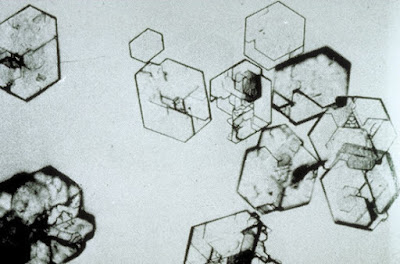Article available in PDF
Naturally, Urine is a solution that contains as many dissolved substances(solutes) eliminated by the body as waste chemicals or substances. These solutes or substances have the abilities to form crystals especially at higher concentration that can equally increase or decrease urine PH from acid to base or viceversa. This condition of presence of crystals in the urine is known as crystalluria. Sometimes crystals are found in healthy people and also be use as indicators of organ dysfunction or failure, presence of urinary tract infections and many other metabolic complications.
The following are good examples of crystals that can be found in Urine
- Uric acid Crystals
- Calcium Oxalate Crystals
- Hippuric Crystals
- Calcium Phosphate Crystals
- Triple Phosphate Crystals
- Calcium Carbonate Crystals
- Ammonium Biurate Crystals
- Bilirubin Crystals
- Cholesterol Crystals
- Cysteine Crystals
- Leucine Crystals
- Tyrosine Crystals
- Sulfa Crystals
- Indinavir Crystals
Uric acid Crystals
 | |
| Uric acid Crystals |
These crystals are of varying sizes and shapes, Mostly found found in acidic urine with PH below 7. Uric Acid crystals turn to resemble rhomboids, parallelograms, or rosettes in shape with an amber color. Though they are seen in normal urine, They also act as an indicator of disease processes, such as acute uric acid nephropathy or urate nephrolithiasis.
Calcium Oxalate Crystals
 | |
| Calcium Oxalate Crystals |
Calcium oxalate crystals are found mostly found in acidic, neutral or alkaline urine. These crystals are colorless when viewed microscopically. Exist two forms of the calcium oxalate crystal: the monohydrate and dihydrate form.
The monohydrate calcium oxalate crystal is described as the “picket fence” form. These dumbbells shaped crystals are common in ethylene glycol toxicity. The dihydrate form is octahedral or “envelope” shaped.
Hippuric acid Crystals
 | |
| Hippuric acid Crystals |
These crystals are also found in normal urine and acid, neutral, or slightly alkaline urine. These colorless crystals are prisms, plates, or needle-like in shape. Hipurric acid crystals are often conglomerated into masses.
Triple Phosphate Crystals or struvite
 | |
| Triple Phosphate Crystals or struvite |
Triple phosphate crystals or struvite stones form in alkaline urine and are composed of magnesium, ammonium and phosphate. Rectangular in shape or similar with the coffin lid. These are sometimes associated with a bacterial urinary tract infection caused by urea splitting bacteria.
Calcium Carbonate Crystals
 | |
| Calcium Carbonate Crystals |
Calcium carbonate crystals can be yellow to colorless appearing as dumbells or spheres with radial striations, found in alkaline urine. They are usually large crystals and can be readily observed at low magnification.
Calcium Phosphate Crystals
 | |
| Calcium Phosphate Crystals |
Colorless crystals having A shape-like blunt ended needles or prisms, rosettes. They can be found in neutral and alkaline pH.
Ammonium Biurate Crystals
 | |
| Ammonium Biurate Crystals |
They will generally appear as brown or yellow-brown spherical bodies with irregular protrusions resembling “throny-apples”. Found in alkaline urine.
Amorphous Crystals
 | |
| Amorphous Crystals |
They are found in acidic urine and may appear pink on gross analysis and yellow microscopically. These crystals appear as granules in the urine sediment.
Amorphous phosphates are found in alkaline urine. These granules are colorless microscopically.They are normal crystals that can be found in urine.
Bilirubin crystals
 | |
| Bilirubin crystals |
These crytals are considered abnormal in urine. They are form from conjugated bilirubin and are needle-like to granular crystals that are yellow in color. They are frequently attached to the surface of cells. These crystals are seen in several hepatic disorders.
Cholesterol Crystals
 | |
| Cholesterol Crystals |
It appear as colorless rectangular plates with a notch in one or more corners and found in acidic urine. The appearance of cholesterol is associated with the Nephrotic Syndrome.
Cysteine Crystals
 | |
| Cysteine Crystals |
They are flat colorless plates and have a characteristic hexagonal shape with equal or unequal sides. It is found in acidic urine that are associated with an inherited disorder. Presence of cystine crystals represents a proximal tubular defect in amino acid reabsorption.
Leucine Crystals
 | |
| Leucine Crystals |
They are Yellowish-brown spheres with concentric circles with radial striations found in acidic and neutral urine. Leucine crystals may be seen in liver disorders in which amino acid metabolism is impaired.
Tyrosine Crystals
 | |
| Tyrosine Crystals |
They appear as colorless/yellow fine needles in acidic and neutral urine. Tyrosine crystals may be seen in tyrosinemia and in certain liver disorders in which amino acid metabolism is impaired.
Sulfanomide Crystals
 | |
| Sulfanomide Crystals |
They are flat needles, sheaves of small needles or as spheroids. Often brown in color. The presence of sulfanomide crystals usually indicates administration of the drug and not necessarily a pathological condition. However, their presence is also associated with kidney stone formation.


